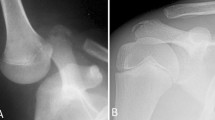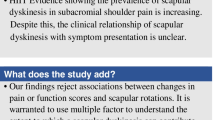Abstract
The objective of this research was to study the course of the pain and the restriction of mobility of the scapulohumeral joint (ROM) over time, and the factors influencing it, in patients with shoulder complaints in general practice. A total of 101 patients participated in this 25-week follow-up study. For the first 2 weeks, a non-steroidal anti-inflammatory drug (NSAID) was prescribed, after that period the physician could follow his usual therapeutic approach. The NSAIDs prescribed during the first 2 weeks resulted in a rapid decrease in the pain and the ROM. The group with the most severe pain consumed the most tablets, which resulted in a significant decrease in the pain and the ROM. It appeared that the course of the pain from week 2 to week 8 was significantly influenced by pain at inclusion, diagnosis and therapy. The most rapid decrease in the ROM appeared in the first 2 weeks. At week 0 and week 2, differences in the ROM were seen in the subgroups for diagnosis, pain score and age. The pain and the ROM showed most decrease in the first weeks. After 6 weeks hardly any changes were seen in the pain score and the ROM score. The margin of the pain score and the ROM score between the “cured” and the “not cured” patients was a very narrow one.
Similar content being viewed by others
References
Adebajo AO, Nash P, Hazleman BL (1990) A prospective double blind dummy placebo controlled study comparing triamcinolone hexacetonide injection with oral diclofenac 50 mg TDS in patients with rotator cuff tendinitis. J Rheumatol 17:1207–1210
Petri M, Dobrow R, Neiman R, et al (1987) Randomised, double-blind placebo-controlled study of the treatment of the painful shoulder. Arthritis Rheum 30:1040–1045
Winters JC, Sobel JS, Groenier KH, Arendzen JH, Meyboomde Jong B (1996) A shoulder pain score; a comprehensive questionnaire for assessing pain in patients with shoulder complaints. Scand J Rehab Med 28:163–167
Sobel JS, Winters JC, Arendzen JH, et al (1995) Shoulder complaints in general practice (in Dutch). Huisarts Wet 38:342–447
Byrk AS, Raudenbush SW (1992) Hierarchical linear models, application and data analysis methods. Sage, London
Prosser R, Rasbash J, Goldstein H (1991) ML3: software for three-level analysis. Institute of Education, University of London
Lacey PH, Dodd GD, Shannon DJ (1984) A double blind, placebo controlled study of piroxicam in the management of acute musculoskeletal disorders. Eur J Rheumatol Inflamm 7:95–104
Famaey JP, Ginsberg F (1984) Treatment of periarthritis of the shoulder: a comparison of ibuprofen and diclofenac. J Int Med Res 12:238–243
Huskisson EC, Bryans R (1983) Diclofenac sodium in the treatment of the painful stiff shoulder. Curr Med Res Opip 8:350–353
Cyriax J (1984) Textbook of orthopaedic medicine, vol 1, chapts 9 and 10, 11th edn. Bailliére Tindall, London
Bakker JF, Jong de AC, Jonquiere M, et al (1990) Shoulder complaints. National Guidelines of the Dutch College for General Practitioners (in Dutch). Huisarts Wet 33:196–202
Author information
Authors and Affiliations
Rights and permissions
About this article
Cite this article
Winters, J.C., Sobel, J.S., Groenier, K.H. et al. The course of pain and the restriction of mobility in patients with shoulder complaints in general practice. Rheumatol Int 16, 219–225 (1997). https://doi.org/10.1007/BF01375652
Received:
Accepted:
Issue Date:
DOI: https://doi.org/10.1007/BF01375652




